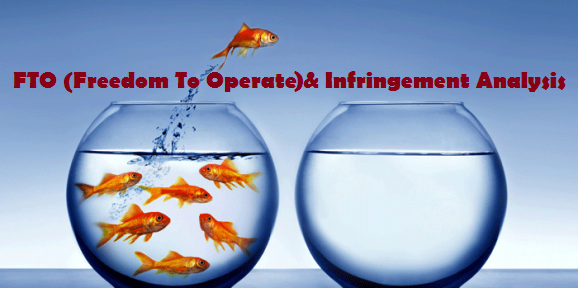This blog post on the difference between FTO and Infringement Analysis is written by Jyoti Chauhan – a registered Patent & Trademark agent.
Mostly people get confused between these two terms. To answer this question one does a patent analysis to ascertain if there is any infringement of a patent to be termed as Patent infringement analysis and the conclusion of said patent analysis can be termed as Freedom to operate opinion and NI opinion.
There are a lot of people who use terms “Freedom to operate opinion” and/or “NI opinion” routinely yet sometimes are confused as to if they are same or different.
As per my understanding, these are actually two different terms yet having a common aspect of infringement opinion.
Freedom-to-operate opinion is basically the advice sought from a patent attorney w.r.t a field of technology and represents a broader infringement analysis provided by the patent attorney with respect to whether a technology will infringe any 3rd party patent.
On the other hand, NI analysis or infringement opinion is the one which is generally directed to a specific patent or patents known to the client.
The client seeks an infringement opinion to get some assurance that a proposed technology will not infringe the specific patent or patents known to him. In contrast, a freedom-to-operate opinion is broader in scope and addresses the potential for infringement by any patents, whether known or unknown to the client.
Both of them differ with respect to the end result desired
When you do a freedom to operate search you would analyze all kinds of literature ie. valid patents, expired patents, non-granted applications, invalidated patents & all non-patent literature to conclude the areas of technology which your organization can work. This would essentially be done at the start of the project.
Whereas a patent infringement analysis for a technology would essentially analyze only valid granted claims for the specific geographical location & to have a futuristic scope – all relevant patent applications.
Freedom-to-operate opinion is generally sought at the beginning of technology development when the client is considering the costs and benefits of the project. For example, the client may be a new entrant in the technological field, and may not have much knowledge of the extent of patenting in that field. Moreover, the client may want to provide some assurance to potential investors that the technology development will not encounter any patent hurdles and that there are no significant barriers to entry. Ideally, the freedom-to-operate opinion will conclude that there are no pertinent patents that would impact the technology development, i.e., that the client is “free to operate” without risk of patent infringement. To the extent that pertinent patents are identified, the opinion provides the client with knowledge that can be used in the technology development process to avoid those patents. Further, the freedom-to-operate opinion enables the client to balance the possible risk of infringement against the expected financial benefits of developing the technology.
In contrast, an infringement opinion is generally sought after a client has notice of the existence of a particular patent. The client may have received a demand letter or license offer from the patent owner or may have independently discovered the patent from a review of trade literature or other publications. The Federal Circuit has said that a person that has actual notice of a U.S. patent “has an affirmative duty to exercise due care to determine whether or not he is infringing. The client may be motivated to seek the infringement opinion in order to satisfy the requisite duty of due care to avoid liability for willful infringement. The client may also use the infringement opinion as a roadmap to design around the patent and thereby avoid the risk of a patent infringement claim. To the extent that a freedom-to-operate opinion identifies patents that are potentially applicable to the technology, thereby implicating the duty of due care, the opinion may further include an infringement opinion that addresses the identified patents in greater detail. Even though infringement and freedom-to-operate opinions have differences in terms of the number and scope of the patents considered, they each address the same fundamental issue of determining whether the technology will infringe a third party’s patent.
While there is some similarity between them, infringement opinions and patentability opinions address fundamentally different issues and are not interchangeable. Infringement opinions focus on whether the technology would infringe the claims of a patent. In contrast, patentability opinions focus on whether the technology would itself be patentable over the prior art, and therefore consider the disclosure of the prior art but not the scope of the claims. There may be some overlap in the patents that are considered, but also some differences. For example, infringement and freedom-to-operate opinions will typically consider only U.S. patents that are still in force, while patentability opinions will consider both expired and non-expired patents as well as international patents and patent applications and non-patent prior art.
A patent infringement analysis consists of two steps. The first step is to construe the claims by determining the meaning and scope of each patent claim limitation. The second step is to compare the properly construed claims to the allegedly infringing device. For the second step, infringement may be either literal or, under certain circumstances, by equivalents pursuant to the Doctrine of Equivalents.
“Freedom to operate”, abbreviated “FTO”, is usually used to mean determining whether a particular action, such as testing or commercialising a product, can be done without infringing valid intellectual property rights of others.
And to generate an FTO – what one does is a “Patent Infringement Analysis”. This involves locating all relevant unexpired patents and subsequent analysis to check if ones proposed product/process is outside the scope of all these patents. If the answer is YES – it is assumed that one actually has an FTO. Such conclusion, along with proper reasoning is what gets documented in an FTO; while the analysis carried out earlier provides the raw data for such an FTO.
FTO opinion would comprise listing and analysis of all relevant patents, published applications and non-patent literature wherein the expired patents, patents expiring before the product launch and non-patent literature (published before the priority date of patents of concern) are cited to support the “Freedom to Operate”, although some patents may be infringed directly or indirectly. It is a comprehensive analysis of all relevant patents, applications published and non-patent literature to defend the “Freedom to Operate” status of the technology in use with respect to all blocking patent claims.
Non-infringement analysis or opinion is generally obtained for one or more specific patents/applications published. This would include a comparison of the claims of the patents/applications of concern vis-a-vis the technology in use or intended.
Patent infringement and freedom-to-operate opinions represent the advice rendered by a patent attorney with respect to whether a technology will infringe a third party’s patent.These are actually two different yet related types of opinions.
An infringement opinion is typically directed to a specific patent or patents of which the client has become aware. The client seeks an infringement opinion to get some assurance that a proposed technology will not infringe the specific patent or patents. However, a freedom-to-operate opinion is broader in scope and addresses the potential for infringement by any patents, whether known or unknown to the client.
The fundamental purpose of such opinions is to advise the client as to whether a technology would infringe a third party’s patent. The technology may include a product or service that the client already makes, sells, or uses or a product or service that the client contemplates making, selling, or using in the future. A client may have already become aware of a particular patent, possibly by receiving actual notice of the patent or by discovering the patent through the course of developing the technology. Or, the client may not be aware of any particular patents and may want to be sure that there are no patents that would impact a technology development. In either case, the client is seeking some assurance that it will not be faced with a potentially expensive and time-consuming patent infringement lawsuit.
A freedom-to-operate opinion is generally sought at the beginning of technology development when the client is considering the costs and benefits of the project. For example, the client may be a new entrant in the technological field and may not have much knowledge of the extent of patenting in that field. Moreover, the client may want to provide some assurance to potential investors that the technology development will not encounter any patent hurdles and that there are no significant barriers to entry. Ideally, the freedom-to-operate opinion will conclude that there are no pertinent patents that would impact the technology development, that is, that the client is “free to operate” without risk of patent infringement.
An infringement opinion is generally sought after a client has notice of the existence of a particular patent. The client may have received a demand letter or license offer from the patent owner or may have independently discovered the patent from a review of trade literature or other publications. The Federal Circuit has said that a person that has actual notice of a US patent “has an affirmative duty to exercise due care to determine whether or not he is infringing.”The client may be motivated to seek the infringement opinion in order to satisfy the requisite duty of due care to avoid liability for willful infringement. The client also may use the infringement opinion as a roadmap to design around the patent and thereby avoid the risk of a patent infringement claim.
Even though infringement and freedom-to-operate opinions have differences in terms of the number and scope of the patents considered, they each address the same fundamental issue of determining whether the technology will infringe a third party’s patent.
I have heard people use the terms to mean different things, depending on where they are and/or in what firm they trained.
I don’t think it really matters what you call it. You should discuss and define with your patent attorney what the opinion will analyze. At the end of the day, you can call it whatever you want and as long as the scope itself is clearly defined in the opinion without relying on the reader to understand how the terms “Freedom to Operate” and/or “Patent Infringement Analysis” are used.
 Serato DJ Crack 2025Serato DJ PRO Crack
Serato DJ Crack 2025Serato DJ PRO Crack











 Allow notifications
Allow notifications




Hi jyoti,
A very informative article highlighting the differences between the important, most commonly and interchangably used terms.
I however am of the opinion as below,
Freedom to operate is carried out jurisdiction wise, depending where the client intends to market the product and also can only be restricted to its competitors if, client is of opinion that his competitors may have patented in other countries important from marketing point of view and hence the analysis gets the term freedom (in marketting) to operate
Patentability search would be before start of prdt development when client wants to patent its idea and wants to make sure its not already in public domain
Non infringment analysis, is in my opinion a subset of FTO whereby , if you find some what relevant patents similar to clients invention, the client does NI analysis to be at peace that its invention is not infringing and also to keep the analysis as backup when sued by the patentee for infringement.